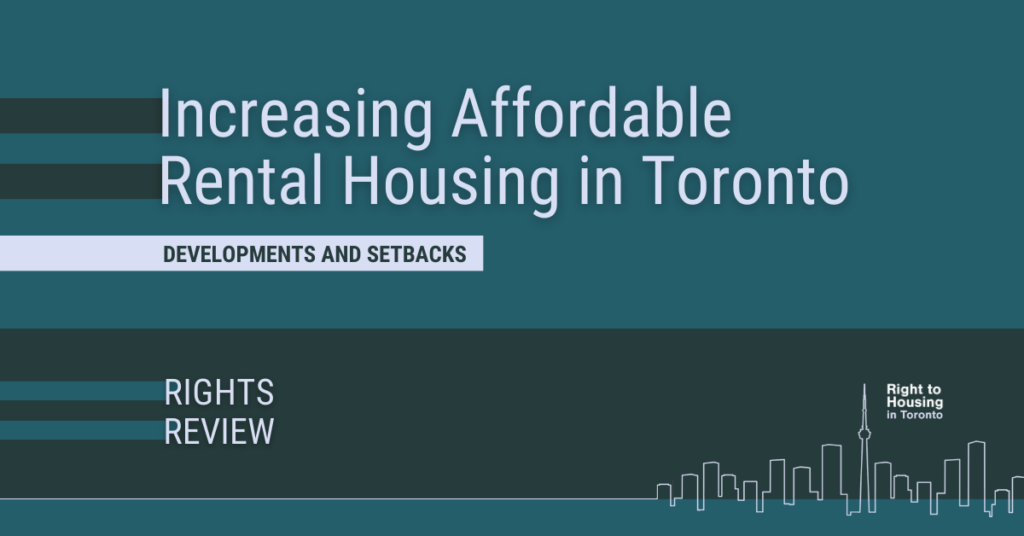May 25, 2023
Toronto’s renters are disproportionately facing the effects of the housing crisis. Compared to 26% of homeowners, 40% of renters are paying more than 30% of their income on shelter, the threshold used to determine whether housing costs are affordable or not. These figures are concerning given that the share of those who will be renting their homes is expected to increase in the future. Without meaningful action, the affordability challenges that so many renters face may worsen.
The deepening affordability crisis in the rental housing market stems from rising demand from low to moderate income households for a stock of rental housing that has not grown at an adequate pace over the past few decades. Any new rental supply that has come into the market is out of reach for a large segment of Toronto’s population.
The Right to Housing Toronto (R2HTO) network earlier built the case for applying a rights-based approach to create more affordable rental housing options for lower income renters in a previous Rights Review. Given the urgency of the situation, it is important to reflect, one year down the line, on the extent to which governments have responded adequately.
A closer look inside the report
Federal and Provincial Action
The federal government had initially shown some promise with the introduction of the National Housing Strategy (NHS), a program that consists of loans and grants to expand and protect affordable housing supply. However, NHS programs such as the Rental Construction Financing Initiative do not appear to have produced housing options that would benefit low- and moderate-income households. While other initiatives, such as the Rapid Housing Initiative, has helped the City move a growing share of people in the shelter system into more permanent housing, inadequate funding in the 2023 budget leaves it unclear whether such progress will be sustained. High interest rates and a weak economy will also make it difficult to finance affordable housing projects.
The province introduced a series of legislations designed to speed up housing construction. While some provisions in these legislations hold some promise, such as in introducing a Community Infrastructure and Housing Accelerator fund to enable municipalities to fast-track permissions for affordable housing, many other measures may be counterproductive. For example, new restrictions on how municipalities can implement Inclusionary Zoning requirements will limit the potential of the policy to create affordable housing options. Several limitations on how municipalities can apply and use development charges is projected to significantly reduce municipal revenues, and in turn make it more difficult for local governments like the City of Toronto to deliver on its increasing set of obligations, including providing affordable housing.
The City of Toronto’s Actions
The City has attempted to use as many levers it has at its disposal to increase affordable housing supply even as uncertainty looms over leadership following the recent resignation of Toronto’s mayor. In our past Rights Review, the Right to Housing Toronto broadly recommended that the City maximize its resources and use all available policy tools to address the housing crisis.
To this end, the City introduced a new vacant home tax and increased property taxes to help fund more services, including housing. It is also finding ways to make better use of its assets, particularly through the Housing Now program which leases City lands for affordable housing projects. There is likely more that the City can do in maximizing its resources, for example through conducting a thorough review of its real estate, and the extent to which these assets can be used for more housing.
Several planning amendments have also created the conditions for more density across the City. These changes address long-standing practices of exclusionary zoning that designated most areas in the city only for single-family homes, and in turn restricted the supply of more diverse forms of housing that today’s residents so desperately need. While the planning amendments hold promise, more conditions and incentives also need to be added to ensure that developers choose to build multistory buildings instead of continuing to build single family homes. Tools should also be explored to ensure that the new developments are affordable for lower and moderate-income households.
Ultimately, all levels of government must collaborate more effectively to help Toronto get out of the housing crisis and alleviate the struggles of a growing share of the city’s population. As of now, inadequate funds from the federal and provincial governments, and many instances of ineffective or counterproductive programs and legislations have made it difficult for the City of Toronto to maneuver effectively.
Adopting a rights-based approach helps ensure all levels of government are committed, aligned, and working towards delivering on housing, especially to meet the needs of some of our lowest income and marginalized households.

